If you visit Portugal during autumn season, you will be amused to find several Chestnut Roasters in the streets of the city’s centers through the country. The smoke and the smell of roasted chestnuts fill the air in a way that it’s appetizingly magical!
There are several locations which are known for being the main producers of chestnuts in Portugal. At the North, passing through Serra da Estrela, you can visit Viseu and Beira-Alta, as well as Trás-os-Montes and Bragança – this can be an extension of your travels, or an interesting way of crossing the boarders to Spain. On the other hand, you can also visit the Marvão and Portalegre’s main producers of chestnuts, when traveling to Alentejo.
When born in the chestnut tree, the chestnut is protected by a coating of spikes - the so-called chestnut hedgehog. When autumn arrives, the hedgehog opens and the chestnut falls to be picked, which may be one of the reasons why the fruit has always been associated with the celebration of this day.
But, the chestnut remained a beloved autumn symbol in Portugal for centuries to the date, not only for its magical taste and appetizing smell, but for its use in Portuguese Cuisine and its link with religious beliefs – The Legend of São Martinho.
About São Martinho’s Legend
The legend of Saint Martin tells that, one day, a Roman soldier named Martin, was on his way to his homeland. The weather was very cold and Martin found an icy beggar who asked him for alms. Martin tore his cloak in two pieces and gave one to the beggar. Suddenly the weather changed, cold stopped and the warm sun appeared. This change in the weather is believed to have been the reward for Martin's being generous to the beggar.Thus, almost always on the eve and on Saint Martin's Day, the weather improves and the sun appears, as happened to Saint Martin and the beggar. This event is known as the “Summer of Saint Martin”.

The November 11th is the day when, traditionally, Portuguese families gathers to celebrate what is called Saint Martin’s “Magusto”, which involves roasting chestnuts and drinking new wine, produced from the previous summer's harvest.
These celebrations have several associated consuetude that are worth remembering, celebrating and savoring. As the chestnut is closely associated with the celebration of Saint Martin's day, November 11th, which is the patron saint of wine and, by habit, new wine is tasted on this day.
The Magic of Chestnut Roasting
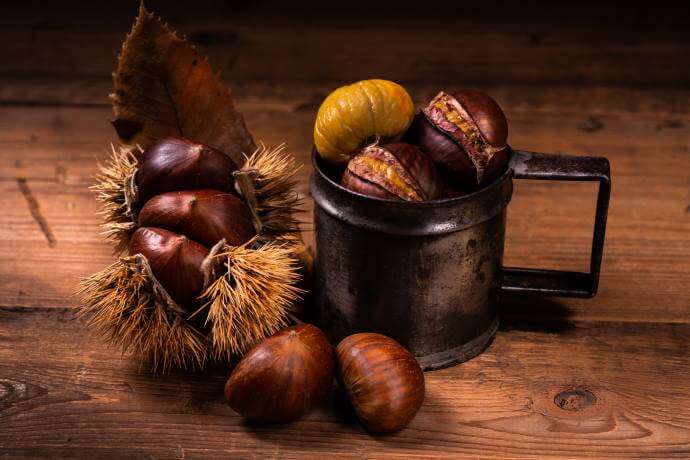
During autumn season in Portugal, it’s very common to find a chestnut roaster in every street corner through Portuguese cities, typically serving hot chestnuts in newspapers cones. Make sure to taste these fine gustatory delicatessen.
In the past, and as it is still possible to find in some Portuguese towns, groups of friends and families gather around a fire where the chestnuts will be roasting, to also drink the Jeropiga, Ginjinha or Agua-pé (wine based beverages). Sweet potato is also very common at this time of year and can be part of the São Martinho’s Magusto.
The chestnut proved to be an easy and versatile product that is being rehabilitated nowadays. It can also be stored after an air drying process or stratified in sand. The pounded chestnut – Pilada – is a perfect example of its versatility in which, after being immersed in water, as beans or grain, then the chestnut can be used in various ways. Nowadays, we also have to add conservation by freezing, which allows having chestnuts throughout the year.
Taste different chestnut dishes and learn about its use in Portuguese Cuisine
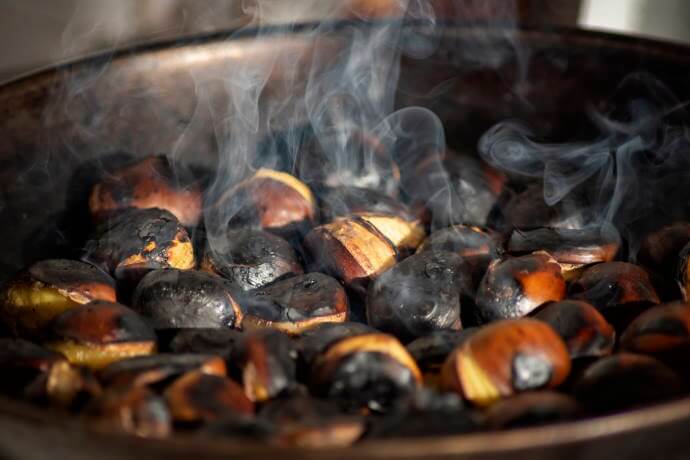
Chestnut was a basic element in Portuguese cuisine, which served to thicken broths and garnish soups and especially used with meat. Sweets were made from this fruit and, especially when reduced to flour, it can be used to make bread. Therefore, it played a very important role in Portuguese cuisine, which decreased with the spread of various cereals. The appearance of the potato, coinciding with the ink disease that attacked chestnut trees which, drastically reduced the production of chestnuts.
However, Portugal is now facing the emergence new recipes using chestnuts and these confections reveal a great imagination and knowledge of the product, thus leaving a new record on its history. Curiously, the area of confectionery is the most lavish, possibly due to the prestige that the great French recipe of “marrons glacés” means to the world of gastronomy.
The versatility of the chestnut turns possible to use it in soups, in many fish dishes, in particular, codfish. It garnishes meats, with a particular fascination for game meat, and transforms confectionery into a special chapter in Portuguese cuisine. But it also serves as a gustatory distraction, as simply roasted or boiled and spread with butter or quince jam. They are also fried and then seasoned with salt and pepper as an aperitif or between meals.
Main Cities Known for Chestnut Production that you can Visit
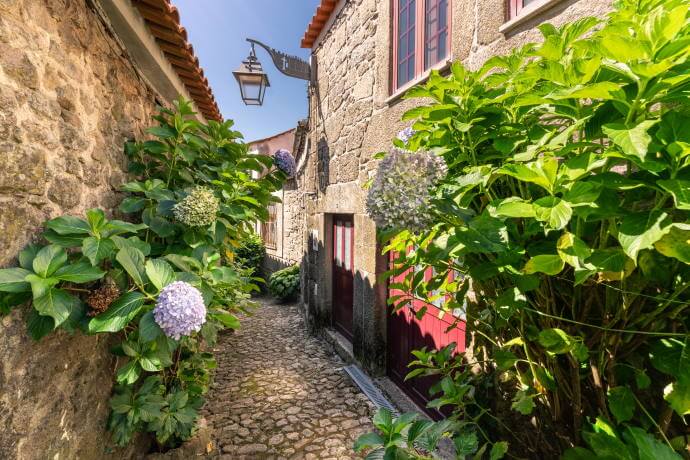
In Portugal, great importance was given to the qualification of chestnuts, classifying them and protecting their origin. Thus, there are four main regions with PDO (Protected Denomination Origin) for Chestnut: Chestnuts of Soutos da Lapa (Viseu, Beira-Alta), Chestnut Marvão (Portalegre, Alentejo), Chestnut of Terra Fria (Chaves, Bragança e Macedo de Cavaleiros) and Chestnut of Padrela (Trás-os-Montes).
If you travel through Central Portugal during autumn, passing the famous Serra da Estrela, you can visit the cities of Viseu and Trancoso - location of the chestnut specie Castanha de Soutos. So, aside from tasting the local gastronomy, made with chestnuts, you can also explore the city of Viseu, with its churches and manor houses built in Baroque style and the medieval city of Trancoso.
The history of Castanha dos Soutos da Lapa PDO is closely linked to this geographical area. The chestnut tree is one of the main trees that grow in this region, and its wood has always been used in civil construction and handicrafts in activities such as basketry and cooperage. The chestnut tree was even considered the "bread tree", so great was the importance it assumed in the economy, food habits and culture. Take a walk at Trancoso Park, which is full of trees, ideal for relaxing and observe the Soutos da Lapa tree species.
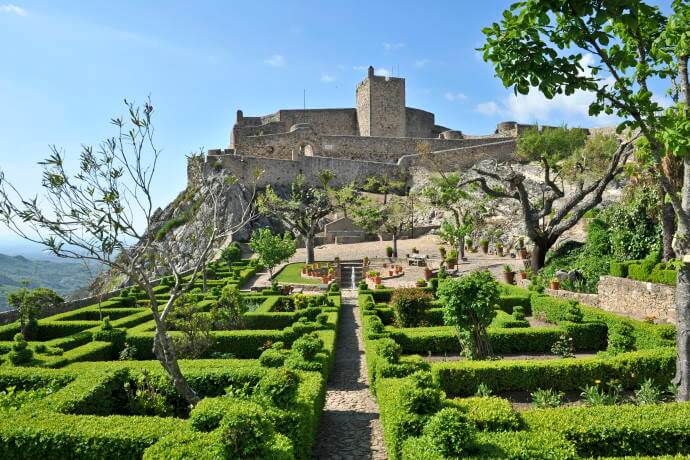
On the other hand, when visiting Alentejo, you can also witness the production and the traditions of chestnuts at Northeast, in Marvão and Portalegre. This region is known for producing another chestnut species named Castanhas Marvão-Portalegre. The chestnut tree and the chestnut are also part of the customs of the Alentejo’s people. Chestnut production serves not only as a human food source, both in its green and dry form, but also for animal feed. There are several regional chestnut dishes, which over time have always been the delight of the Alentejo’s people, such as: chestnut soup, pork with chestnut, turkey with chestnut and chestnut flour. After sitting down for these delicious meals, you can venture walking up to Marvão castle and enjoy the fantastic view over the Alentejo plains.
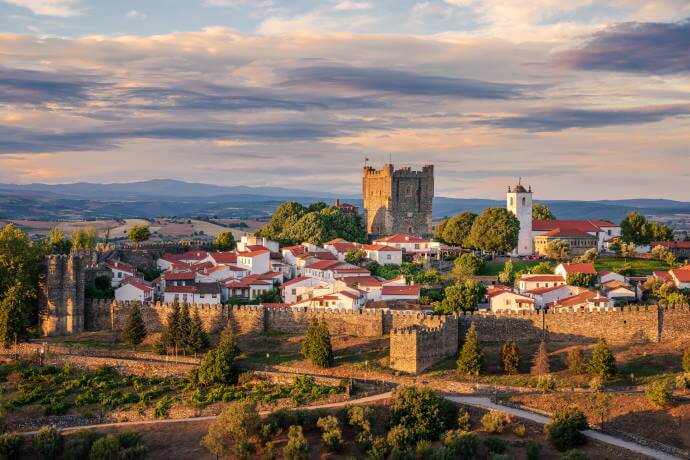
If you take a trip to northern interior of Portugal, be sure to visit the friendly city of Chaves and the city of Bragança, as they are also known for chestnuts production and as they can provide great options for extending your visit through the north of Portugal, or even as stop-byes when crossing the board to Spain.
In this region different species of chestnuts are produced – the Chestnut Terra-Fria and Chestnut of Padrela. The presence of the chestnut tree in this region, known as Trás-os-Montes, dates back thousands of years, being produced there like nowhere else in the world. Having established ties of interdependence between this tree and the people of this region, as the chestnut has represented one of the main food sources.
The chestnut traditions in Portugal, are one of the innumerous unmissable attractions during autumn equinox. So, if you ever take a trip to Portugal during this season, make sure to visit some of the locations mentioned above. Be ready to find a chestnut roaster in every corner of the country and, fortunately, buy a newspaper cone of roasted chestnuts, or taste the superb dishes made with this versatile ingredient.




